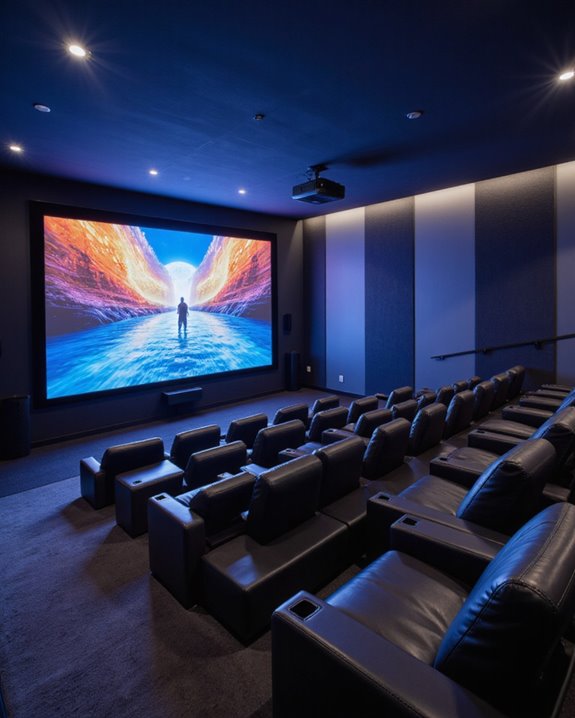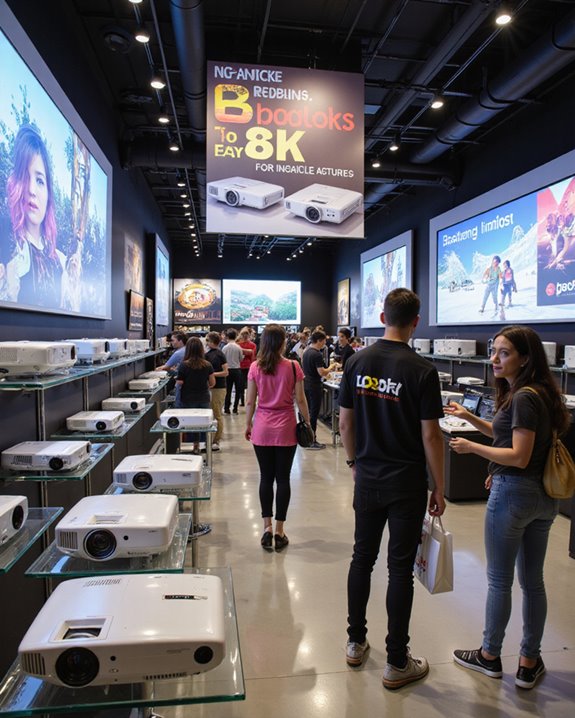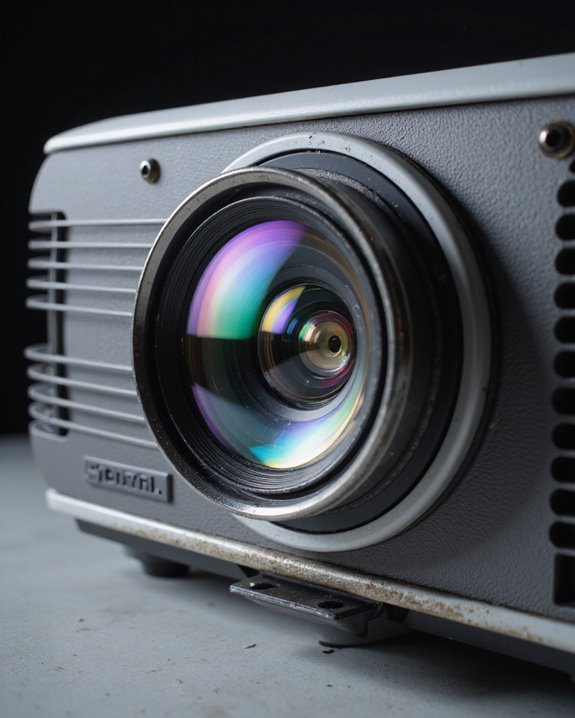Projector screen gain is a number showing how much light a screen reflects compared to a standard white board, directly affecting brightness and viewing angles. A gain of 1.0 means equal reflection, while higher numbers increase brightness but narrow the most effective viewing area. Key factors influencing gain include screen material, surface texture, and ambient light. Different gains suit various rooms and projectors; for example, high gain works in bright spaces. More details help with selecting the right screen for any situation.
Key Takeaways
- Projector screen gain measures how much light a screen reflects compared to a standard white reference surface.
- A higher gain increases image brightness but narrows the viewing angle and risks hot spotting.
- Lower gain screens offer wider viewing angles and more uniform brightness, ideal for larger audiences or home theaters.
- Proper gain selection balances room lighting, projector brightness, and desired viewing experience.
- Technological advancements in screen coatings and materials help optimize gain, reduce glare, and improve image quality in various environments.
Defining Projector Screen Gain
Projector screen gain is a key measurement that describes how much light a projection screen reflects compared to a standard white board. The gain number is a ratio, with 1.0 meaning the screen and white board reflect the same amount of light. Historical gain standards provide a baseline for these measurements and are certified for consistency. Gain is determined using a light meter at a zero-degree viewing angle, directly in front of the screen. Screens with a gain above 1.0 are considered high gain, while those below 1.0 are low or fractional gain. Material, surface design, and tinting—such as using gray screens—affect gain and may influence color temperature effects, sometimes shifting the appearance of whites or colors. Certified standards help guarantee uniformity. Additionally, understanding the display technology and brightness levels can further optimize viewing experiences depending on the environment.
How Screen Gain Influences Image Brightness
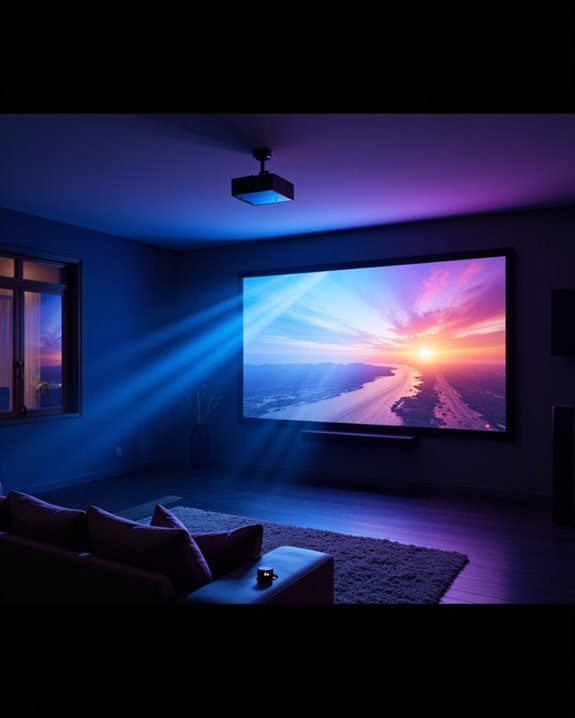
Screen gain directly impacts how much light a screen surface reflects compared to a standard white surface (gain of 1.0). A higher screen gain increases image brightness, making it ideal for rooms with significant ambient lighting or larger screen sizes. Key considerations include:
- High gain (2.0–3.0): Best for bright environments or low-lumen projectors, but can introduce hotspots and reduce color uniformity.
- Medium gain (1.5–2.0): Balances brightness and moderate ambient lighting, suitable for most home or office settings.
- Low gain (0.6–1.5): Offers even brightness across the screen surface, but may appear dim in well-lit rooms.
Selecting the appropriate gain depends on room lighting, projector brightness, and screen size. Additionally, understanding how display technologies influence gain can help optimize image quality for specific viewing conditions.
The Relationship Between Gain and Viewing Angles
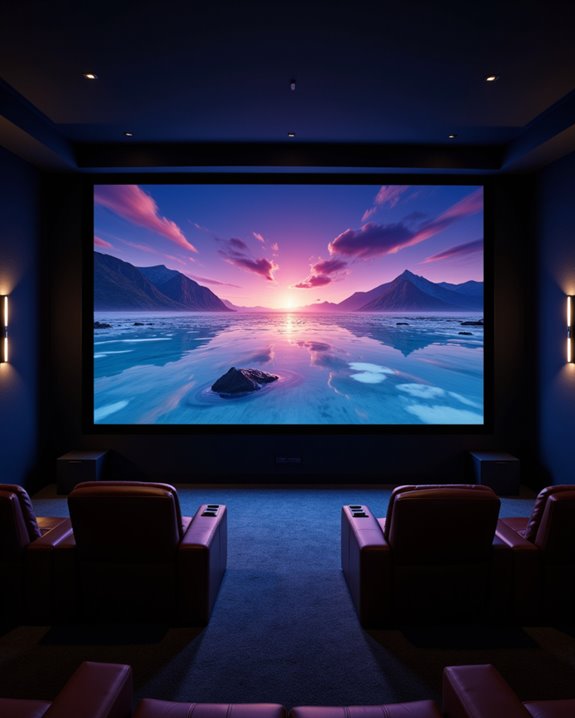
When evaluating the relationship between gain and viewing angles, it is essential to understand that gain measures how much light a surface reflects back towards the audience compared to a standard reference surface, usually given a value of 1.0. Higher gain screens focus reflected light towards the center, making the image brighter for viewers sitting directly in front. However, this also means a narrower viewing angle—viewers sitting off to the sides may notice dimmer images or darker corners. Common screen gain myths suggest higher gain is always better, but in reality:
- Lower gain screens offer wider viewing angles and more uniform images.
- The “half gain angle”—where brightness drops to half—defines the effective viewing area.
- The perceived image quality can also be affected by projection technology, which influences how brightness and angles interact in different models.
Viewer perception greatly depends on seating arrangement and room conditions, not just gain alone.
Types of Screen Gain and Their Characteristics
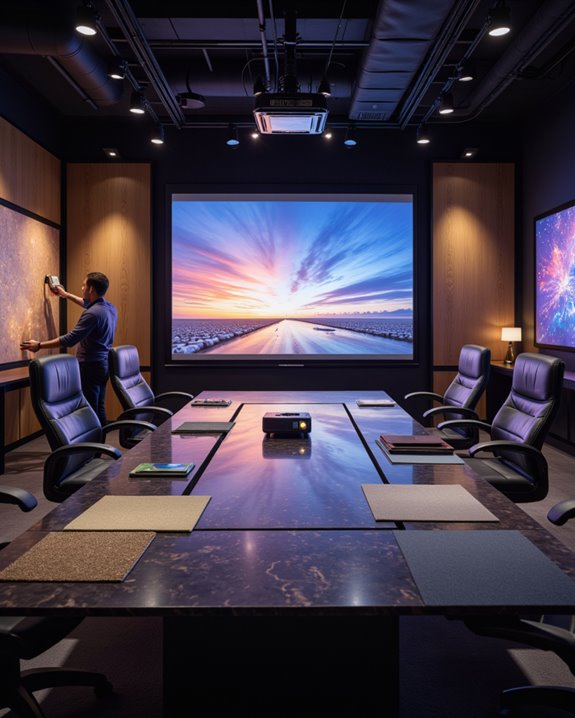
How does screen gain affect the viewing experience in different settings? Screen gain, which measures how much light a screen reflects to viewers, ranges from 0.6 to 3.0. High-gain screens (gain > 1) amplify brightness, making them ideal for rooms with significant ambient light. However, they often limit viewing angles due to their specialized screen surface textures. Standard gain screens (gain = 1) offer even brightness, wide viewing angles, and work well in controlled lighting. Low-gain screens (gain < 1) diffuse light, providing the broadest viewing angles and are suitable for larger audiences.
- Gray screens, a type of low-gain screen, enhance contrast in partially lit spaces.
- Rear projection screens often use low gain for consistent light distribution.
Ambient light considerations and projector brightness must guide the choice of screen type.
Understanding the Impact of Gain on Color and Contrast
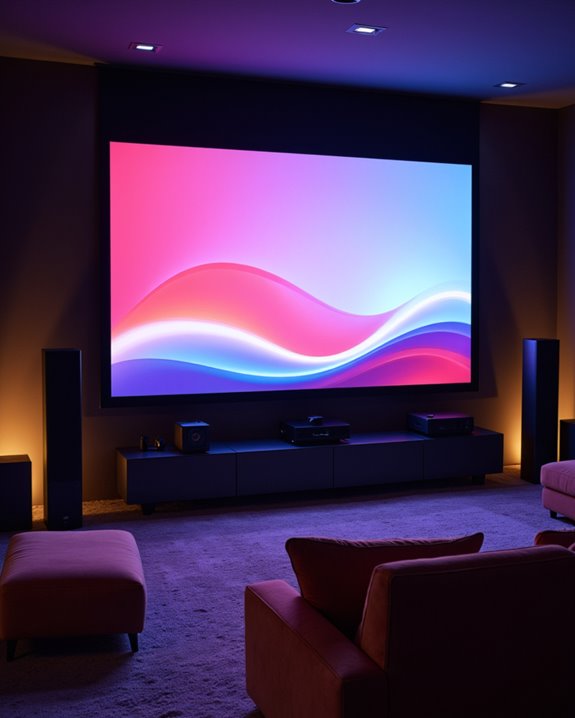
Why does screen gain matter for color and contrast? Screen gain, which measures how much light a projector screen reflects compared to a standard, directly affects both color accuracy and contrast. High gain screens (above 1.5) may boost brightness in well-lit rooms with high ambient light, but often compromise color accuracy due to hotspots and uneven light distribution. Lower gain screens (0.8 to 1.0) offer improved color depth and maintain color vibrancy in low ambient light.
Key points include:
- Contrast ratio, the difference between dark and light areas, is higher with low gain screens, improving black levels and enhancing cinematic quality.
- Viewing angle widens with lower gain, ensuring consistent color across the screen.
- Screen material, such as gray surfaces, can increase contrast but slightly reduce color brightness.
Proper gain selection balances color fidelity and viewing conditions.
Tools and Methods for Measuring Screen Gain

Accurate measurement of screen gain is fundamental for evaluating how a projector screen performs, particularly with respect to color and contrast. Screen gain is defined as the ratio of the luminance, or brightness, of a test screen to that of a Lambertian diffuser—a surface that reflects light evenly in all directions—under identical conditions. Measurement requires a controlled, dark environment to avoid measuring ambient light, which could skew results. Calibrating luminance meters, such as imaging photometers, ensures precise brightness data. Goniometer-based BRDF (Bidirectional Reflectance Distribution Function) devices measure how light reflects off the screen at various angles. Key steps include:
- Illuminating screens nearly perpendicular to the surface
- Taking luminance readings every 5 degrees
- Generating gain maps to identify hotspots and gain variations
These methods ensure reliable, repeatable screen gain measurements.
Comparing Screen Gains Across Different Materials
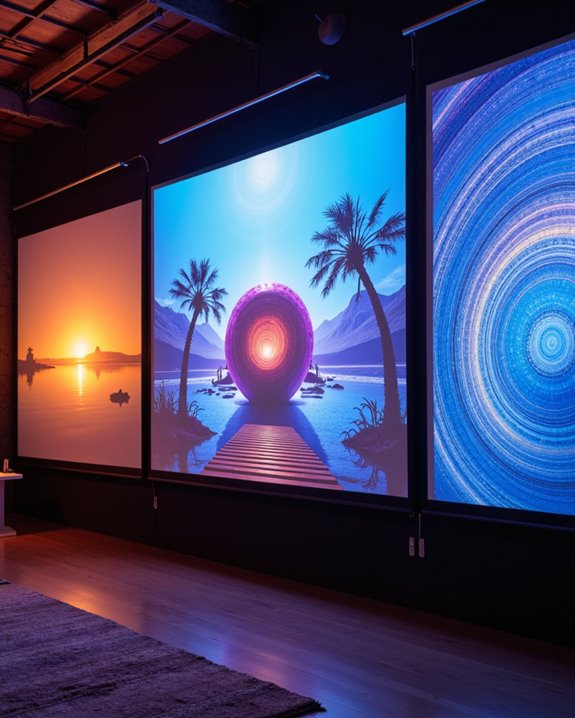
When evaluating projector screens, comparing screen gains across different materials is essential for understanding image brightness and quality. Screen gain measures how much light a material reflects, with categories such as low gain (0.5–0.9), neutral gain (1.0), and high gain (1.1–2.5). Each material—like CineWhite ISF, gray screens, or ambient light rejecting (ALR) surfaces—offers unique performance:
- Low gain screens use gray or white materials for enhanced contrast, but may appear dim in bright rooms.
- Neutral gain screens, often made from standard white materials, provide balanced brightness and color accuracy.
- High gain materials, including textured surfaces, increase image brightness but can reduce contrast.
Screen material durability varies by type, affecting lifespan. Environmental impact of screens depends on the manufacturing process and material recyclability.
Factors to Consider When Selecting Screen Gain
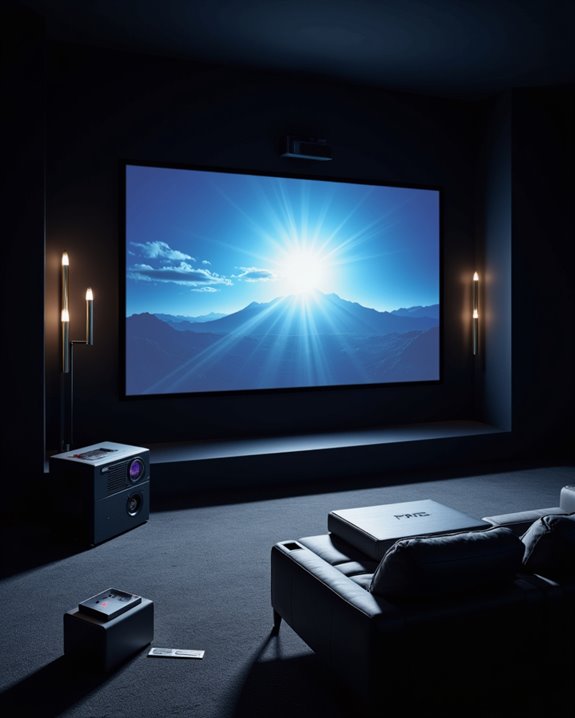
Selecting the appropriate screen gain is a key decision that directly influences projected image brightness and overall viewing quality. Screen gain, which measures how much light a screen reflects compared to a standard reference, must be matched to several important factors:
- Ambient light control: In bright rooms, high-gain screens (greater than 1.5) enhance visibility, while low-gain options (0.6–1.3) suit darker environments.
- Projector brightness: Dim projectors benefit from higher gain, while powerful projectors can use lower gain screens without loss of brightness.
- Screen surface textures: Smooth finishes typically increase gain but may reduce viewing angles; textured surfaces diffuse light for even viewing.
- Seating arrangement: High-gain screens are best for central seating, while low-gain screens maintain image quality across wide angles.
Balancing these factors ensures ideal performance.
Screen Gain Applications in Various Environments
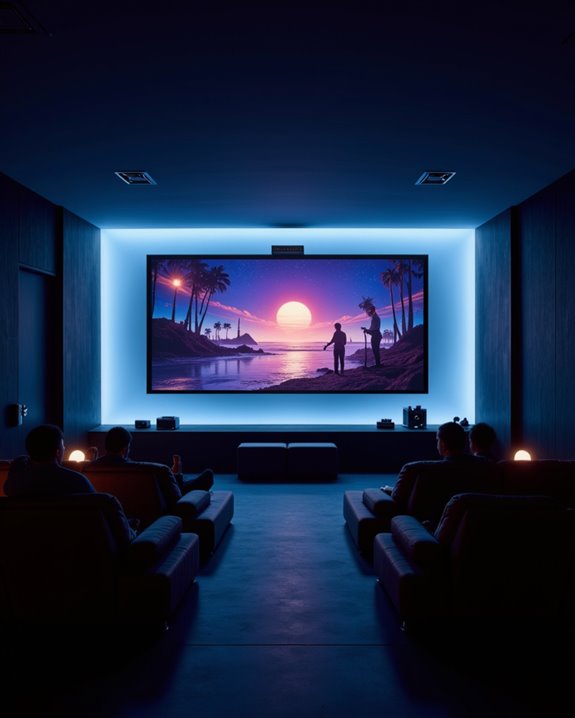
How does screen gain impact different viewing environments? Screen gain, which measures how much light a screen material reflects compared to a standard white reference, directly shapes image quality under varying lighting conditions. In home theaters, low-gain screens excel because they provide uniform brightness and maintain color accuracy in dark, controlled spaces. For meeting rooms or conference halls with bright lights, high-gain screens are preferred; these materials enhance image brightness but have narrower viewing angles, best for audiences seated centrally.
- Outdoor events require high-gain screens that resist ambient light, ensuring clear images even in daylight.
- Public venues often use standard gain screens, balancing brightness and wide viewing angles for diverse seating.
- Educational settings may use adjustable gain screens, allowing flexible adaptation to different lighting conditions, projectors, and presentation needs.
Advancements in Screen Gain Technology
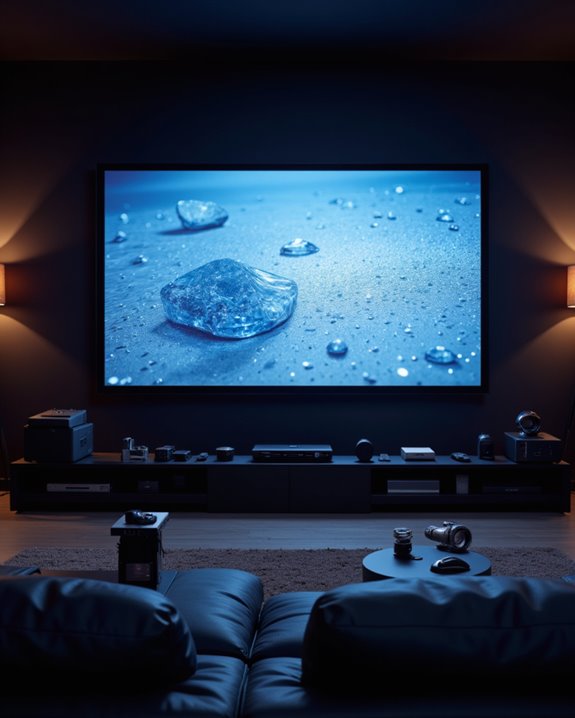
Although screen gain has long influenced projector image quality, recent technological advancements have considerably changed how screens manage light. Multi-layer reflective coatings now maximize projector light reflectivity while minimizing issues like hotspotting and color shift. These coatings also improve coating durability, helping screens maintain peak performance even when exposed to ambient light—unwanted light from windows or room fixtures. Ambient Light Rejecting (ALR) screens use optical filters and advanced coatings to reject ambient light, boosting image clarity and color accuracy in bright environments. Material innovations—such as glass bead surfaces and engineered polymers—further enhance gain and image uniformity. Additionally, micro-lens structures and variable gain zones allow screens to direct light precisely, balancing brightness and viewing angle. These developments collectively ensure strong, consistent performance in diverse lighting conditions.
Frequently Asked Questions
Can I Change the Gain of an Existing Projector Screen?
When considering changing projector screen gain, adjustment techniques are limited since gain is determined by the screen’s material. Material modifications, such as applying reflective coatings, are generally impractical and may degrade image quality, making replacement preferable.
Do Screen Gain Values Degrade Over Time With Use?
Coincidentally, as screen durability faces repeated environmental and usage stresses, the reflective properties of a projector screen can degrade over time. Factors like dust, light exposure, and improper maintenance contribute to declining screen gain values with continued use.
How Does Screen Gain Affect 3D Projection Performance?
Screen gain directly influences 3D projection performance by enhancing projection brightness, which is vital for clear 3D images. However, higher gain may narrow viewing angles and potentially impact color accuracy, affecting overall 3D viewing experience and audience comfort.
Are There Health Effects From Using High-Gain Screens?
High-gain screens may contribute to eye strain and glare issues due to increased image brightness. Prolonged viewing can result in digital eye fatigue, dryness, and discomfort. Mitigation strategies include adjusting brightness and encouraging regular breaks during use.
Is Screen Gain Relevant for Ultra-Short-Throw Projectors?
Like sunglasses filtering sunlight, screen gain shapes how ultra-short-throw projectors handle ambient light and screen brightness. Lower gain screens, especially gray ones, help these projectors reject ambient light, boosting contrast and delivering improved image quality in bright environments.

